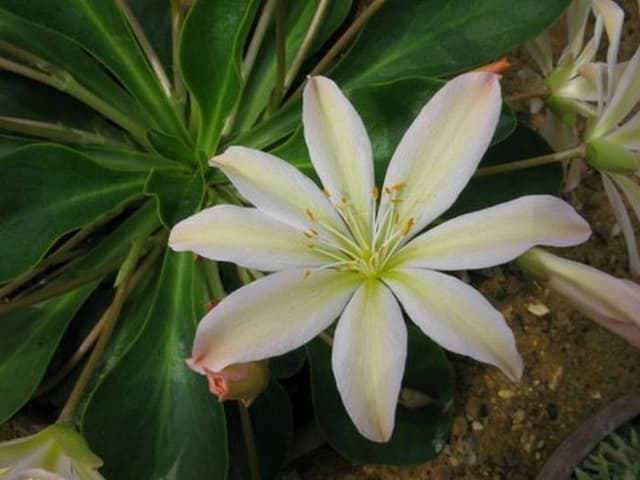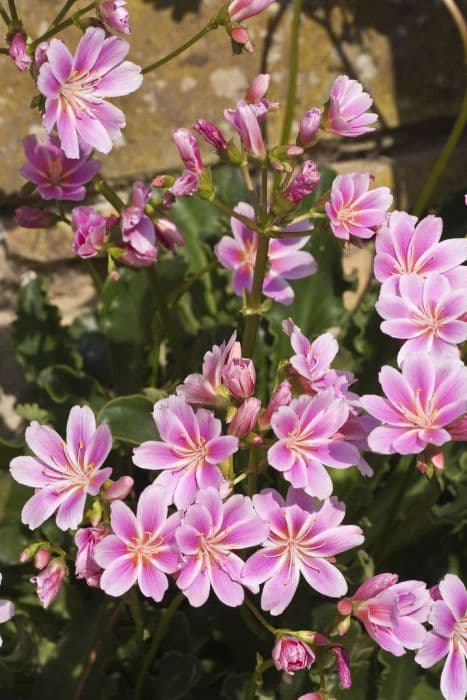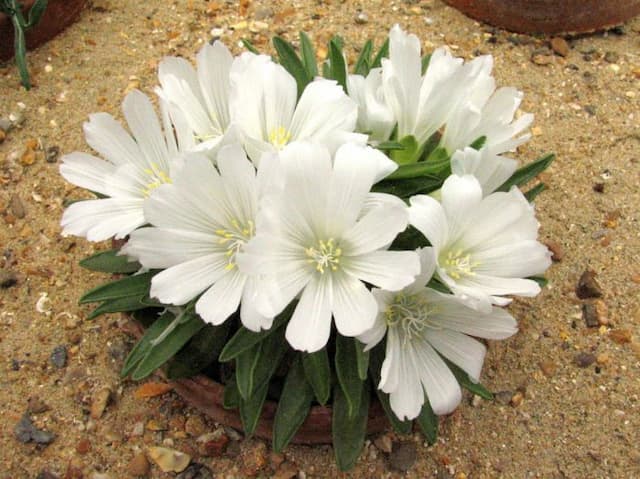Bitterroot Lewisia 'Little Mango' (Little Series)

ABOUT
Lewisia 'Little Mango' from the Little Series is distinguished by its charming and vibrant appearance. The plant boasts succulent, evergreen rosettes of fleshy, spoon-shaped leaves that form a neat, textured mound. During the blooming period, the foliage becomes a backdrop to the stunning flowers. The blossoms are delightful, equipped with a captivating mango hue that slightly gradates to a softer, pale yellow toward the center. Each petal is delicately attached, contributing to a rounded flower form that beams cheerfully atop sturdy, slender stems. These stems rise just above the foliage, giving the plant a look of a modest floral bouquet. The effervescent flowers exude a sense of energy and warmth, making them a standout in any garden or container where they are welcome bursts of color.
About this plant
 Names
NamesFamily
Montiaceae
Synonyms
Little Mango Bitterroot, Little Mango Lewisia
Common names
Lewisia 'Little Mango' (Little Series).
 Toxicity
ToxicityTo humans
The plant commonly known as Lewisia is not widely recognized for being toxic to humans. There are no well-documented cases of poisoning from consuming Lewisia, as it is not typically regarded as an edible plant. However, as with any plant not intended for consumption, individual sensitivities could potentially cause mild stomach upset or an allergic reaction if ingested. To be safe, it's best to avoid eating any part of the Lewisia plant.
To pets
Lewisia is not commonly known to be toxic to pets such as dogs and cats. There is no significant evidence or reports to suggest that pets would experience severe symptoms of poisoning from ingesting this plant. However, ingestion of non-food plants can sometimes result in gastrointestinal upset in pets, such as vomiting or diarrhea, due to the irritation of the stomach or intestines. It is always prudent to keep an eye on pets and prevent them from eating plants that are not part of their regular diet.
 Characteristics
CharacteristicsLife cycle
Perennials
Foliage type
Evergreen
Color of leaves
Green
Flower color
Orange
Height
0.5 feet (15 cm)
Spread
1 feet (30 cm)
Plant type
Herb
Hardiness zones
Varies
Native area
North America
Benefits
 General Benefits
General Benefits- Attractive Blooms: Featuring vibrant orange flowers, the Lewisia 'Little Mango' adds a splash of color to gardens and attracts pollinators.
- Drought Tolerance: Once established, this plant has low water needs, making it ideal for xeric or drought-prone gardens.
- Compact Size: Its small stature allows it to fit into rock gardens, alpine displays, or small spaces where larger plants might overpower.
- Adaptable: While preferring well-draining soil, this plant can adapt to a range of soil types if drainage is adequate.
- Low Maintenance: Minimal pruning requirements and resistance to many pests make this plant easy to care for.
- Versatility: Suitable for containers, borders, or as a ground cover, providing flexibility in garden design.
 Medical Properties
Medical PropertiesThis plant is not used for medical purposes.
 Air-purifying Qualities
Air-purifying QualitiesThis plant is not specifically known for air purifying qualities.
 Other Uses
Other Uses- Lewisias like 'Little Mango' can be used as part of a living roof or green roof setup, providing seasonal color and helping to insulate the building below.
- These plants can be used in miniature rock gardens or fairy gardens due to their small size and attractive foliage and flowers.
- They can serve as a natural method for soil erosion control on slopes or in areas with loose soil because of their ability to grow in rocky conditions.
- Lewisias can be utilized in xeriscaping, a landscaping technique that reduces the need for irrigation, thanks to their drought tolerance.
- Their vibrant flowers can be inspirational for artists or photographers looking for natural subjects with intense colors.
- When planted in a school or educational garden, 'Little Mango' can be used to teach children about alpine plants and their adaptations to harsh environments.
- They can be used as a natural indicator of the seasons, with their blooming patterns signaling the transition from spring to summer.
- Lewisias, like 'Little Mango', can be used to create a gradient of color in a rock wall or along a stone pathway where they can nestle into crevices.
- In thematic gardening, they can represent the mountainous regions of the Americas as part of a geographical or regional display.
- These plants, with their attractive blooms, can be used in container gardens on balconies or patios where ground planting isn't an option.
Interesting Facts
 Feng Shui
Feng ShuiThe plant Lewisia is not used in Feng Shui practice.
 Zodiac Sign Compitability
Zodiac Sign CompitabilityThe plant Lewisia is not used in astrology practice.
 Plant Symbolism
Plant Symbolism- Resilience: Lewisia, known for its ability to thrive in rocky, inhospitable terrains, symbolizes the ability to persevere and flourish in the face of adversity and hard conditions.
- Beauty: With its vibrant, mango-colored flowers, the 'Little Mango' epitomizes the beauty found in nature, indicating an appreciation for the aesthetics and joys that plants can bring into our lives.
- Adaptability: The 'Little Mango' shows great adaptability by surviving in less than ideal soil conditions, representing the trait of adjusting to various environments or situations with ease.
- Simplicity: As a member of the Little Series known for its compact form, this plant suggests a love for the simple things in life and the beauty in minimalism.
 Water
WaterFor Bitterroot, it's essential to mimic its natural alpine habitat. Water the plant deeply but infrequently, allowing the soil to dry out completely between waterings. During the growing season in spring and early summer, water approximately once a week, using about 8 ounces of water per plant, avoiding water logging. During the dormant period in late summer to winter, reduce watering to once a month or less, depending on the humidity of your environment. Always check the soil moisture before watering to prevent overwatering, which can cause root rot.
 Light
LightBitterroot thrives in bright, indirect sunlight and should be placed in a location where it can receive several hours of morning sunlight with partial shade in the afternoon. An east or west-facing window is ideal, providing a mix of sun and shade throughout the day. Avoid direct midday sun, which can be too intense and may scorch the plant's leaves.
 Temperature
TemperatureBitterroot prefers cooler temperatures and can tolerate a range from about 40 to 75 degrees Fahrenheit. It's important to avoid temperatures below 30 degrees Fahrenheit, to prevent freezing, and above 80 degrees Fahrenheit, as excessive heat can stress the plant. The ideal temperature for Bitterroot is within 50-70 degrees Fahrenheit, closely mirroring its native mountainous climate.
 Pruning
PruningPrune Bitterroot to remove spent flowers and dead foliage, maintaining its compact shape and encouraging the plant to produce more blooms. The best time to prune is immediately after the flowering period, usually in late spring or early summer. Prune occasionally, and remove only the necessary parts to avoid stress to the plant.
 Cleaning
CleaningAs needed
 Soil
SoilThe best soil mix for Lewisia 'Little Mango' should be well-draining and gritty, such as a mixture of potting soil, coarse sand, and fine pumice or perlite. The soil pH should be slightly acidic to neutral, ranging from 6.0 to 7.0.
 Repotting
RepottingLewisia 'Little Mango' should be repotted every 2 to 3 years or when it becomes root-bound. The best time to repot is in the spring, just before the growing season begins.
 Humidity & Misting
Humidity & MistingLewisia 'Little Mango' prefers moderate humidity levels, avoiding extremely high humidity which can lead to rot. Aim for humidity levels between 40% and 50%.
 Suitable locations
Suitable locationsIndoor
Place in bright, indirect light and ensure good air circulation.
Outdoor
Full sun to part shade with excellent drainage.
Hardiness zone
4-8 USDA
 Life cycle
Life cycleLewisia 'Little Mango' begins its life cycle as a seed, which, after experiencing a period of cold stratification, will germinate when exposed to warmer temperatures and sufficient moisture. The seedling stage follows, during which the first roots and shoots emerge, slowly developing into a rosette of succulent leaves. In vegetative growth, the plant matures and stores energy, preparing for flowering. During the flowering stage, usually in late spring to summer, 'Little Mango' produces vibrant, mango-colored blossoms with multiple petals atop slender stalks, attracting pollinators. After pollination, the plant sets seed, completing its reproductive cycle. In the final stage, the perennial Lewisia 'Little Mango' enters dormancy in the winter, with its foliage often dying back, to regrow again from the rootstock with the return of favorable conditions in spring.
 Propogation
PropogationPropogation time
Spring-Early Summer
The Lewisia 'Little Mango' (Little Series) can be propagated mainly through division, ideally done in the spring. To propagate by division, carefully remove the plant from its pot and gently separate the rosettes, ensuring each new section has roots attached. These divisions can then be replanted into individual pots filled with a well-draining soil mix, lightly firmed down, and watered in. It's important to keep the newly potted divisions in a bright spot out of direct sunlight while they establish roots, maintaining consistent moisture without allowing the soil to become waterlogged.




